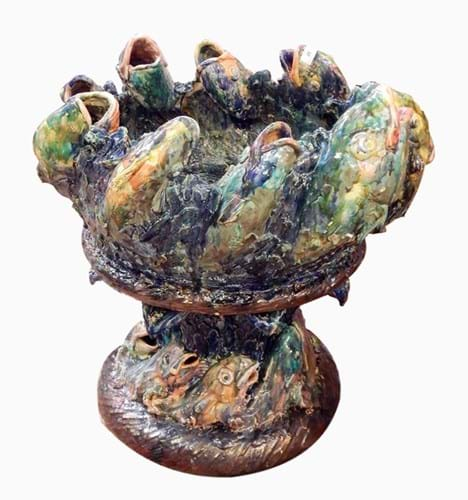
ATG has covered many sales where studio pottery lots deliver impressive results, including the extraordinary Firth collection housed in a modest bungalow on the outskirts of Leeds. Assembled for about £27,000, it made a £861,460 hammer total at Adam Partridge auctioneers in Macclesfield on October 16 last year.
BBC2’s The Great British Pottery Throw Down has become an unlikely TV hit, and one of the judges – Kate Malone – is part of a new wave of studio potters following on from Rie and Coper. She is known for the imaginative, brightly coloured sculptural pots she has been producing in her London studio since the 1980s. Her overall work ranges from modest eggcups or mugs to whole building facades.
Shapes are often based on organic matter such as fruit and flowers and a strong theme in her early work was marine flora and fauna – fish, seaweed, starfish and shellfish.
Cotswold Auction
A sale to be held by The Cotswold Auction Company on August 6 will offer Malone designs including early vases, jugs, a fruit dish, a candelabrum, a bathroom shelf and ceramic tiles, all painted with or moulded in the form of fish, crustaceans and other seaside themes.
The items have been consigned from the collection of a Notting Hill studio pottery enthusiast who knew Malone well and had followed her work from the first stages. Also included in the sale from the same collection are ceramic works by John Maltby and Rachel Kneebone.
Malone’s pieces are currently on show at Waddesdon Manor in Aylesbury, Buckinghamshire, this summer with other contemporary artists. Her work is also in the permanent collections of the Victoria and Albert Museum, London, Manchester City Art Gallery and the Ashmolean Museum, Oxford.
Studio Movement
The British studio ceramics movement began in the early 20th century, carrying on a long tradition of producing objects by hand from clay. A good opportunity to view such pottery is now available at York Art Gallery, which opened two new galleries last year to form the Centre of Ceramic Arts (CoCA).
The gallery say CoCA is now “the world’s most extensive and representative of British studio ceramics, with more than 5000 pieces”. As well as work by Rie and Coper, it includes designs by Bernard Leach, Shoji Hamada, William Staite Murray, Michael Cardew, Jim Malone and Mick Casson.





